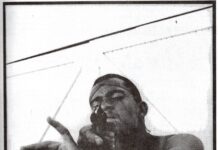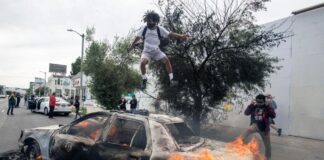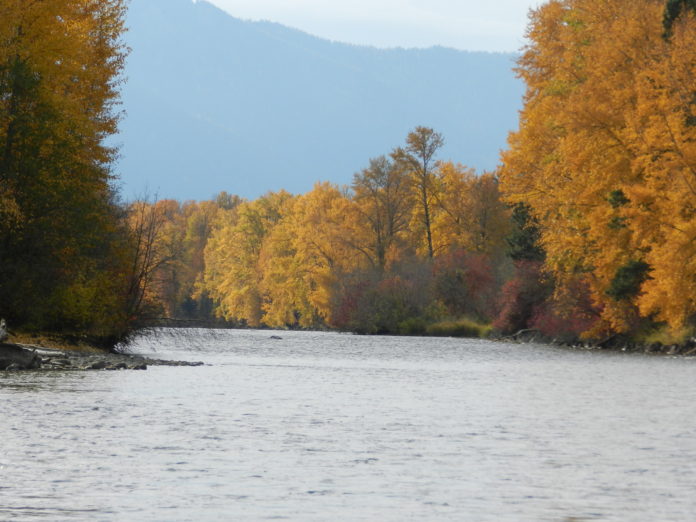
The simple life remains on the other side of the mountain
By Mark Cromer
It’s late October and autumn is settling across the North Cascades, rolling out its golden carpets with crimson adornments in the valleys and along the riversides both east and west of the Snoqualmie Pass in Northern Washington. As I stand alongside the Yakima River just outside of Cle Elum on the eastern side of the pass, taking in the bright brush strokes of nature’s annual shedding, I am struck by the vibrant, celebratory nature of this cyclical slow death and the reassurance that can be found in the flora’s fall revelry.
While perhaps not precisely in the middle of nowhere, I am pleasantly on the outskirts of it and as a cold wind heralds the approach of a storm unfurling from the North Pacific, I marvel at that most rare gift to be discovered in the modern era: human silence, with the only sounds emergent rising from the river and the wind-stirred trees.
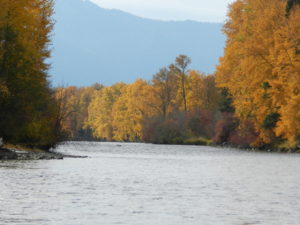
I linger here along the riverside, taking a slow stroll beneath the golden canopy to savor nature’s spell unbroken by humanity, pondering why it is that fall is associated with melancholy, given the brilliance of its passing and the promise of renewal that it whispers. True autumn in all of its glory is the ‘going away on sabbatical’ bash that nature throws for itself even while planning its ‘welcome back’ garden party for the following spring, but perhaps fall touches some with melancholy because the spring and summer of their lives left them with a meager harvest to appreciate in the fall before the winter of their years is upon them.
A season that begs reflection may well portend a cruel early frost for those who squandered their days lost in pursuit of the means to an end that they never quite reached or perhaps really even wanted, ground away on the millstone of a relentless day-to-day, be it for Wal-Mart or Wall Street, only to find themselves reminded by nature’s third quarter that the dusk approaches, ready or not.
Gazing along the rushing clear water of the Yakima, it’s a prism through which I can measure my own days gone by and feel content in my life’s journey up the mountain on paths less traveled and warmed by the memories of those long honey days and summer nights that I did not let slip away but rather reveled in the glow of their countless bonfires until they, like my youth, burned down to ashes and sand.
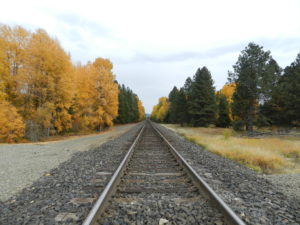
And in the sweeping rush of this river amid the fall I am once more reminded of how sweet and simple life remains on this side of the mountain and in this place and time, a pleasant refresher for a man in his 50s who now confronts the inevitable downslope of the remaining days ahead that seem to be growing shorter with each passing one of them. It makes me laugh a little at how far and fast I traveled up the mountain only to be overtaken by the desire to coast for awhile on the other side of it.
And Cle Elum is a fine place to linger in the fall.
As I make my way along the western end of 1st Street into the small coal mining and logging town that for the most part sits north of Interstate 90’s run between Seattle and Spokane, I pass multiple signs welcoming travelers into this mountain outpost of around 2,000 people that first rose in 1880s to be eventually christened ‘The Heart of The Cascades.’ It’s the signage equivalent of the Laguna Greeter, a ‘welcome’ followed by a ‘good to see you’ and a ‘glad you’re here,’ the understandable subtext of which is ‘for God’s sake please pull over somewhere and walk our streets, visit our mom and pop stores and hopefully open your wallet a time or two.’
In places like Cle Elum, that’s actually a lovely invitation that pays much more than it costs. There’s a lot to see and take in and almost all of it is free for the asking.
I am reminded of this as I find my way back to an old church at the northwest corner of Oakes Avenue and 2nd Street that I discovered earlier this year when I was struck by its postcard-like image of America: Then & Now. Under renovation, the century-plus old chapel appears like a Norman Rockwell painting with its white clapboard siding and faded key lime roofing that pinnacles into a small belfry topped with a battered wooden cross. Framed on this afternoon by the storm that’s rolling across the mountains, the church appears even more as a snapshot out of time, with a portrait of Jack Kennedy in one of its windows, a faded American flag nailed to the sanctuary’s eastern side, a solid-white old GMC delivery van parked on the lot next to it on the western side with one sign in its window reading ‘We Need Jobs Now!’ and the other—above the driver’s seat—stating simply ‘Sold By.’
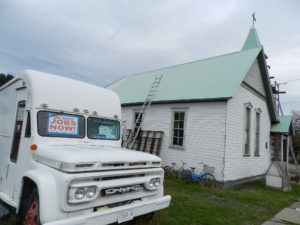
Sitting on a chair in the doorway to the chapel is Michelle, a middle-aged woman who is one half of the couple that bought the church and is restoring to eventually become their home. We chat for awhile outside and she offers to let me take a look at the restoration work inside the church, which as painstaking as it has been I quickly learn has resulted in some beautiful handcrafted woodwork along the renovated ceiling and a plank-by-plank repair or replace effort along the chapel’s stripped walls. Two large antique Round Oak wood-burning stoves are in the main building and will become part of their home, Michelle tells me, but the work is methodical and its completion not yet in sight.
I ask her about the ‘Great Fire of 1918’ that consumed most of Cle Elum, a blaze that burned nearly 30 blocks of the town’s core, and she said the church appeared to be one of the buildings that had survived the fire that local lore holds was started with the wayward flick of a cigarette. During the renovation, Michelle said, the couple has discovered artifacts of a sort, from coal dust in the walls, along with a mummified cat and ash.
And the bell in the belfry still rings. Stepping back into the foyer, she reaches behind a door and unhooks a rope. “Give it a ring,” she says. I pull the rope gently down, but nothing. “You gotta really pull it,” she says and I give it a sharper jerk downward and find myself in mild awe as the bell above begins to toll, a graceful, rolling ring that I realize can be heard across this small town. Of all the adventures big and small across my years, the sublime satisfaction of being allowed to ring a church bell in a quaint American town suddenly finds itself on my cool experience memory log.
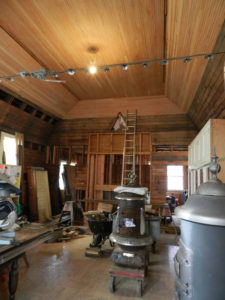
Walking east along the town’s main drag of 1st Street I find my way back into The Caboose, one of the local bars I also discovered during an earlier outing into The Cascades. Nestled next to a fly fishing outfit called Troutwater, patrons of The Caboose pass wooden pews positioned outside on the sidewalk in front of the saloon as they head into a church of a different sort for services and sacraments of a different and yet equally enduring kind. As bars go, The Caboose is a comfortable watering hole that’s a little too bright and with enough polish to be a dive and yet with more local character and authentic flavor to be confused with a chain operation or an upscale joint.
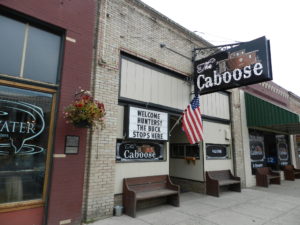
The bartender, a blonde sparkplug named Kelsey, pours me a Stoli, tonic and lime and I take my drink out to the smoker’s lounge on the back patio to put my feet up and watch the clouds so ripe with rain roll across the sky, pregnant with downpour but not yet delivering. The back patio at The Caboose is covered with signs from a bygone era and as a country tune wafts through the speakers my eye catches the sign that reads ‘Hippies Use Side Door, No Exceptions’ and am instantly taken back to Pappy & Harriet’s, the classic roadhouse in Joshua Tree where Gram Parsons had retreated after The Byrds and The Flying Burrito Brothers. Last November I had journeyed out to Joshua Tree with an old crew of LA writers for a psychedelic weekend and the ensuing cosmic light show in the desert night sky, a literal trip that started over dinner and drinks at Pappy & Harriet’s where I recall the back patio was also still festooned with its original ‘Hippies Use Side Door’ sign.
As I recline and enjoy the cloud show that’s whirling above, I realize that The Caboose does indeed remind me a little of Pappy & Harriet’s, a similar rustic sensibility that’s augmented with servings of country honk and the right ratio of liquid mind enhancements. It has been a year since my friends and I spent a weekend taking in the starlight adornments of that vast night sky after we split Pappy & Harriet’s to our vantage point at the edge of the desert in a well-known artist’s home we had rented for the occasion of conducting our own Electric Marmalade Psilocybin Test, and as I unwind for a spell again in this crisp autumn air in Northern Washington I marvel at where the road of life has taken me in the days that followed our flashing fall sojourn in the twilight of 2015. A few days after returning from the desert I caught a flight to Hawaii to spend a week with my girlfriend hiking up Diamond Head and drinking ourselves into the sunset on the beach at The Moana Hotel, only to wake up one morning swimming in the warm Pacific off the sands of Waikiki. As I drifted around just past the breakers, taking in the palm-tousled shoreline, it was at once surreal and yet comforting. I felt like an old Roman legionnaire floating pleasantly with the tides of the empire, or perhaps more like Joe Walsh coming off the Hotel California tour and checking back into the Polo Lounge. A couple of weeks later I was walking around Manhattan on a long weekend spent entirely getting lost in New York, from West Harlem to a stroll across the Brooklyn Bridge, taking the advice of Art Garfunkel and soaking up the eternal bustle of Gotham where I’d come to revisit once more some of the places I spent a few of my formative years as a writer. The Village in the fall still crawls with beats and bohemians in the bistros, not counting those with AmEx platinum cards.
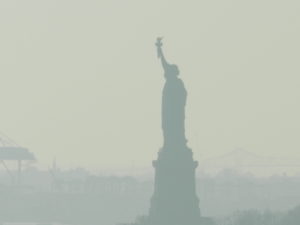
I returned to LA only to split again a week later, this time flying back to Boston where I hung out for a week with another writer who’s an old friend of mine, kicking around her hometown in South Boston, wandering the once rough and tumble streets that Whitey Bulger’s Winter Hill Gang ran before he split to the West Coast and obscurity that didn’t last quite as long as he had hoped. So a friend in need is a friend indeed and I had come back to Boston to hang out with a trusted one and unpack a few years of my life. And she was there. Beautiful. Sharp. Kind. Irish. Catholic.
I recall the first time I walked into her pad way back when she had an IRA provo banner up in the corner of her living room that prompted me to call her ‘the fire of Eire,’ a moniker that would stick among some of our fellow ink-slingers only to be evoked for years later three pours after the last one in the wee hours. Well, this time around we hit some of Whitey’s old bars where we reflected on the passage of our time and the unexpected turns life takes no matter where you think you’re headed. Our days of newspapering were over, gone with the era those broadsheets and tabloids had so long represented, and we knew we were lucky to have been the last generation to sweat deadlines and fickle sources in newsrooms that rattled and hummed and clattered and bounced as reporters composed like Syphilitic Mozarts, their fingers running mad across the keyboards and with phones nestled into their necks, talking and listening and writing all at once, all to file before deadline and then head over to the hotel bar for a drink and the group therapy of the daily post-mortem. In this long slow pour of the wake, we determined those were fine days indeed.
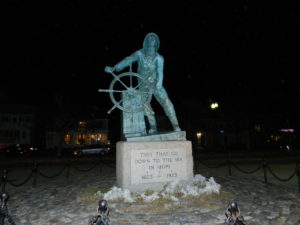
And we agreed love is a bitch that will never die, yet newspapers was one that did.
Catching a train up to Gloucester, I returned to the Crow’s Nest bar on the harbor, the working class fishermen’s tavern and inn made more famous by its depiction in The Perfect Storm and where I first had a few rounds one long summer road trip three decades earlier. Nothing much seemed to have changed in either the Crow’s Nest or the rough harbor town it serves. Later that night I made my way over to the ‘Man at the Wheel’ memorial that was erected in 1925 and gazed upon the stoic fisherman eternally frozen in that cold December air of 2015, after nearly a century of his standing watch over the town’s eulogy for their fallen of three hundred years: ‘They that go down to the sea in ships 1623 – 1923’
I remember thinking how powerfully poignant such a gracefully simple monument was to those men who went down in the sea and an unintended testament to what Joan Didion had driven home in her The Year of Magical Thinking: “Life changes in the ordinary instant.” One moment you’re sailing the high seas, the next a raging ocean is swallowing your vessel whole. And hours after that, as your wreckage settles to the bottom, above are glassy calm waters and crystalline skies of azure as time continues apace without missing a beat, save your own heart’s. Here today, gone later today.
And what does it all mean? Or does it?
Since the end of last year I’ve continued to spend my time between LA and Northern Washington, repeatedly returning to the north country in search not of answers but rather of what life has to be found in places like Port Townsend, Port Gamble and Port Angeles, Anacortes and the San Juan Islands, where my long search to watch Orca pods prowl their waters finally came to fruition on the Salish Sea this summer. I’ve continued to wander from outposts like Fall City and crisscrossed the verdant farmland from Carnation to Snohomish to Lake Stevens and Marysville, always looking for those tucked away gems like the Last Frontier Saloon or the Anchor Inn, hole in the walls where good people still look you in the eye and share the stories of their lives and loves in these places they call home.
And it all brings me back to Cle Elum as the rain drops finally start to fall lightly on my outstretched legs and boots on the chair in front of me. The long road of life leading me here, to this small town bar named for the end of a train, and I smile when I think of the casual serendipity of the moment. The season and the locale meshing nicely in my mind with a remark Dennis Wilson once told a reporter: “They say I’ve lived a fast life and it can’t go on forever, and maybe that’s true. But man, the memories sure will.”
Kelsey brings me another drink as I enjoy the drizzle.
Later, I make my way east along 1st Street for a few blocks that comprise about half of town’s main street, passing the stoic brick buildings that either survived the great blaze that torched the town a century before or arose shortly after it, store fronts like Cle Elum Drug, the Telephone Museum (yes, you read that correctly), Owen’s Meats and bunkers like the Post Office, which back when always seemed to be built like they might be under attack at any moment. The Port Townsend Post Office actually appears like it might have doubled as a 19th Century fort overlooking the harbor. I pass a 1940’s era gas station that I had stumbled across earlier this summer; dead and gutted and still with a ‘For Sale’ sign posted above the door.
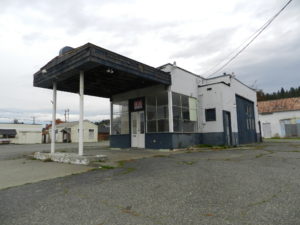
Wrap around big pane windows in the front and an old service bay door on the side, it’s a rare gem in the rough, one that still radiates some residual Neal Cassidy poetry from that frantically epic joyride so long ago. I dial the number once more and it’s still the same voicemail greeting from a towing outfit that sounds like they’ve gone fishing or maybe to a barbeque but if you’re interested in Uncle Bill’s old service station, leave a price and number and maybe they’ll let you know.
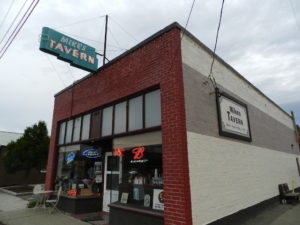
Further down the road I again find the harbor light of Mike’s Tavern, the bottom rocker of Cle Elum’s colors, a properly stripped down joint that serves beer and wine to the good folk amid severed deer heads. Its walls are graced with testaments to the men who built this town and much of the country that surrounds it, including one poignant photo of the townsmen gathered along 1st Street and holding aloft all manner of steel pots and pans, some of the men sporting the lids on their heads. They wear suits and ties, overalls, police uniforms and service station ensemble, fit men and men wearing their pants like Fred Mertz, belted above the belly buttons on their larded guts, but all of them with a hardened look of life in their mid-20th Century time. The veterans from Teddy Roosevelt’s Rough Riders stand on the ends, dutifully holding Old Glory. A local told me the photograph was taken when the town had finally raised enough metal in a drive to be matched by the mills and Uncle Sam for a new fire truck.
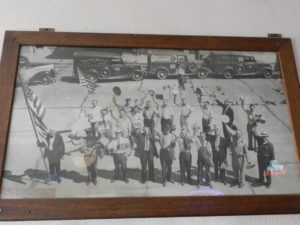
Another photo on the wall captures a scene inside the bar in the same era and I am struck by the stark black and white beauty of the moment it froze. The photographer snapped the shot from behind the bar, facing 1st Street, and the tavern’s address of 427 can be seen in reverse through the glass front door, along with the neon in the windows advertising Rainier Beer above the heads of five patrons and the bartender, who appears to be in a uniform of sorts. Or perhaps he wasn’t the bartender at all, but rather a serviceman who had stepped behind the bar to wash his hands, as he appears to be shaking them. Maybe the bartender took the photo. Whoever took it, they caught a moment of five working men at the bar, three of them dressed for business and looking at the cat behind the bar, a fourth appearing rather dapper and seeming somewhat lost in digression and the fifth is sporting a flannel shirt and a driver’s cap, his arms folded in front of him on the bar and a hard look in his eyes as he stares directly at the camera.
What a night that must have been.
And here it is now, forever on the wall at the same joint where it happened.
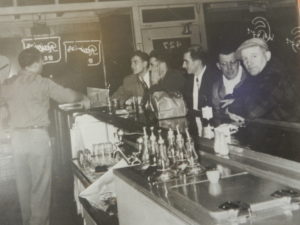
As I gaze at the photo for a second I realize it seems like I’ve caught a glimpse of myself and suddenly I feel like Jack Nicholson’s writer in The Shining, finally saddling up at that ghostly bar in the empty Overlook to tell the bartender: “That’s swell. I like you, Lloyd, I always liked you. You were always the best of them. The best goddamn bartender from Timbuktu to Portland, Maine. Or Portland, Oregon, for that matter.”
I leave Mike’s Tavern and cross the street where I pause in front of Three Forks Ammo & Reloading, another slice of the American pie served up in a long and thin building with a mural on its easterly side pointing to Washington D.C. that sends a quiet message the Beltway has ignored like a smoker’s cough that doesn’t go away. A silhouetted mountain man in buckskin and cradling his long gun stands in front of a mountain and a sky painted candy orange by the setting sun, and the mountain man is pointing to the east, perhaps to the Oval Office, Congress and their limousine class courtiers. As I gauge it, I can’t decide if he’s saying “Shame on you!” or “Back off, you’ve been warned!” but I suppose it makes no difference, as it telegraphs the gist of either one rather finely. Like most every other shop in Cle Elum, the Stars & Stripes are proudly displayed out front and I just wish millionaire quarterback Colin Kaepernick would wear his ‘white cop pig socks’ here on this street and waltz into the Three Forks to protest the flag of ‘oppression’ they’re flying proudly out front. It’s only a passing thought, but one that warms me with a chuckle, as I can almost hear the gunfire now.
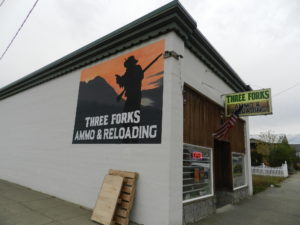
I amble back through town and on the way to my car I am suddenly and sadly reminded that the smack epidemic reaches even this far north and deep as a 30-something white dude rolls up Bullitt Avenue on me at a quick clip, sporting a bomber jacket and a battered knapsack thrown over his shoulder, and as he closes in I spy the ‘88’ tattoo on his neck and figure while he may be in the right neighborhood he’s definitely about to bark up the wrong tree.
We lock eyes and I can tell he’s sick yet hopeful.
“Hey man,” he says. “Can you help a brother out with some change or whatever you can spare?”
“Brother, I just spent it.”
I’m still walking west and he’s still walking north and neither one of us break our stride but neither one of us break our gaze for a moment more, and his stare tells me ‘You’re a lying sack of shit’ and my grin telegraphs back ‘You’re a junked-up loser out for a fix, beg elsewhere.’
He says “Alright man, thanks.”
I reply “Hang in, bro.”
And I keep walking west to my car, and he keeps heading north to his next B&E.
Driving west, I make my way along Hundley Road, taking just a little more time to savor the landscape in its lush autumn splendor and to once more inhale the simple beauty of the sticks side of Northern Washington, a place that but a few years before I had casually dubbed ‘Palin Country’ as I walked around it with my girl, the two of us marveling beyond the trees at the rifle-racked, pick-up trucks that passed us by with Hank Jr. blasting and nothing harder being served at the roadside parties than good drinks and loose joints. I’ve always dug Sarah and, well, this just seems like her rogue sort of country. White folk doing as white folk do. Believe me, Toby Keith’s ‘I Love This Bar’ was more of a documentary than a music video. At any rate, I figure it’s always good to be home with your people and we always dug it.
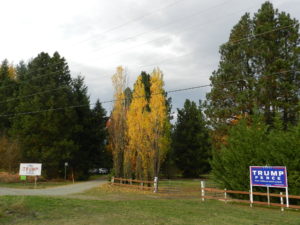
I am reminded of this as I see the big twin ‘Trump 2016’ signs alongside the road, one official and one handmade, that reinforce just a tad louder the message splashed in the mural alongside Three Forks Ammo & Reloading back in town. I pull my car over and get out to take a picture or two, laughing to myself that I just wish some of those ‘university students’ (and I once was one, a long time ago when ideological opposition was welcomed on campus as part of one’s education) were out here now, raging at the sight of such Trump ‘hate speech’ and tearing into these billboards as they’ve felt so confident to do on their campuses, or as the street thugs feel inclined to do in places like San Jose, Chicago or Gotham. I can almost hear the roar of the shotgun and the crisp pops of the AR-15 that would deliver the ‘No Trespassing’ advisory as the protestors started screaming amid their own Kent State, or more specifically, the sign they ignored until those full metal jackets were ripping through their bodies that read: ‘The Constitution is alive and well here and will be defended.’
But that joke to myself vanishes as I lower my camera to see a guy emerge from the golden brush just off the side of the hand-painted Trump sign. He was just standing there, with a hunter’s cap on, the kind with the flaps that fall down around the ears, leather on top and sheep wool inside, but the flaps were pinned up, as I could see his ears. He had a beige jacket on, but I couldn’t see his hands, which were down below the brush, and I couldn’t see the gun I thought he might be holding.
We just stood there, for a moment.
I knew he could see my camera and my car and he must have been watching me photograph his Trump signs, not try to tear them up. But the look on his face, even at a hundred-plus feet, said ‘Not Welcome.’
I wanted to tell him ‘Look, I forgot the code word, but I’m on your side. I agree. Don’t shoot!’
But I repressed that urge, instead lifting my hands up with my camera, smiled at him and nodded. He didn’t smile but he nodded back, and then I walked back to my car. Inside, I looked back up and he was gone, or at least no longer visible. And it was a strange thing, as that was when my dread turned back into pride in my people, those serious folk that will stand up outta nowhere—armed and dangerous—if they suspect someone is about to mess with what’s theirs. Don’t tread on them.
And I am once again reminded of the great American poet laureate, Charles Manson, who when asked by a reporter who he actually was replied: “I’m nobody. I’m a tramp. A bum. A hobo. I’m a boxcar and a jug of wine. And a straight razor, if you get too close to me.”
The great white north in America, 2016.
The dusk was fading into night as I got back onto the I-90, heading back over the Snoqualmie Pass, indulged once more by the brilliance of the snow that had capped the mountains around me, yet another reminder that fall does turn to winter, for all of us.
I roll the window down and let the October wind whip inside and while Cle Elum is behind me for now, well I realize what’s actually in my rearview is a life I am glad to have lived. And I know this is the time and the place to understand it.
Digging life on the other side of the mountain, or as a girl once told me, ‘you’re on the other side of the morning.’ And later that became ‘You’re just off the plane.’
And maybe I am just off the plane that landed on the other side of the morning, but as life would have it, I’m just glad I caught the flight.
I keep on driving over the pass and back down to Issaquah and my little getaway pad there, where I know I’ll meet some friends just to put my boots up again, and we’ll play The Eagles One Of These Nights over and over again, lift our glasses, light our smokes and revel in the now of our once what was.
And at some point I’ll just have to say: “Have you cats been to Cle Elum?”
Because if you haven’t, you definitely should.



